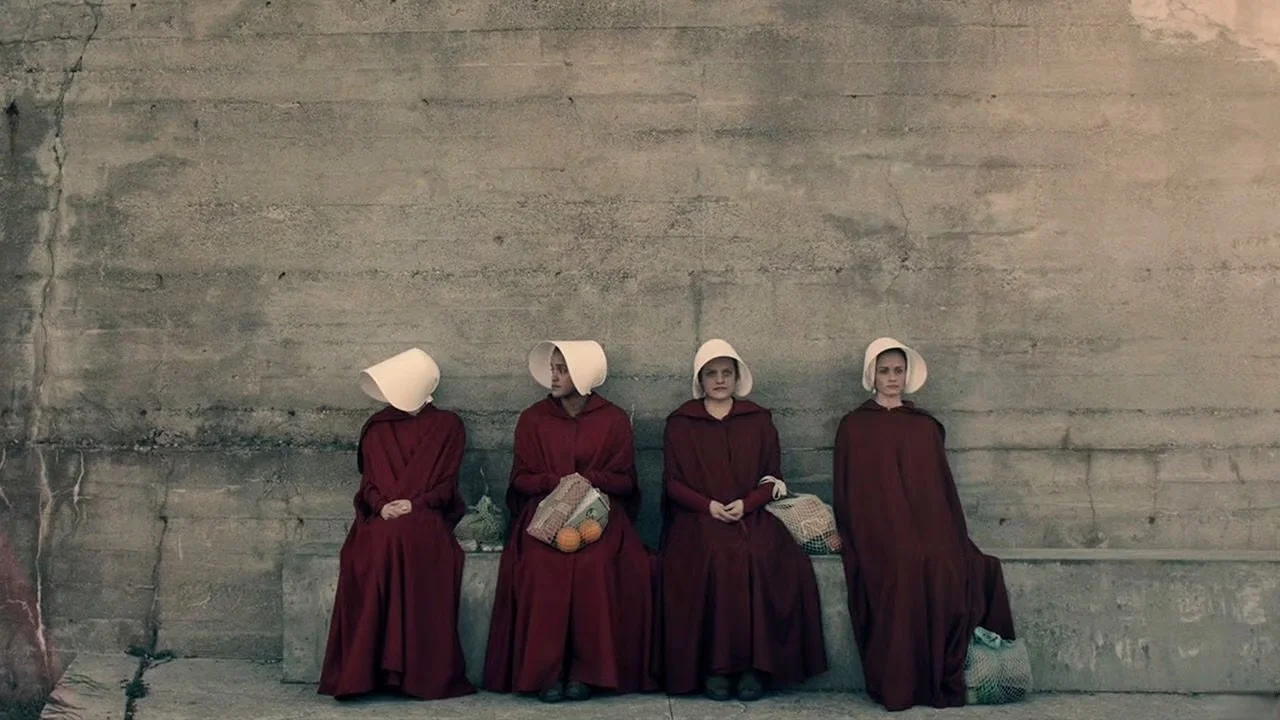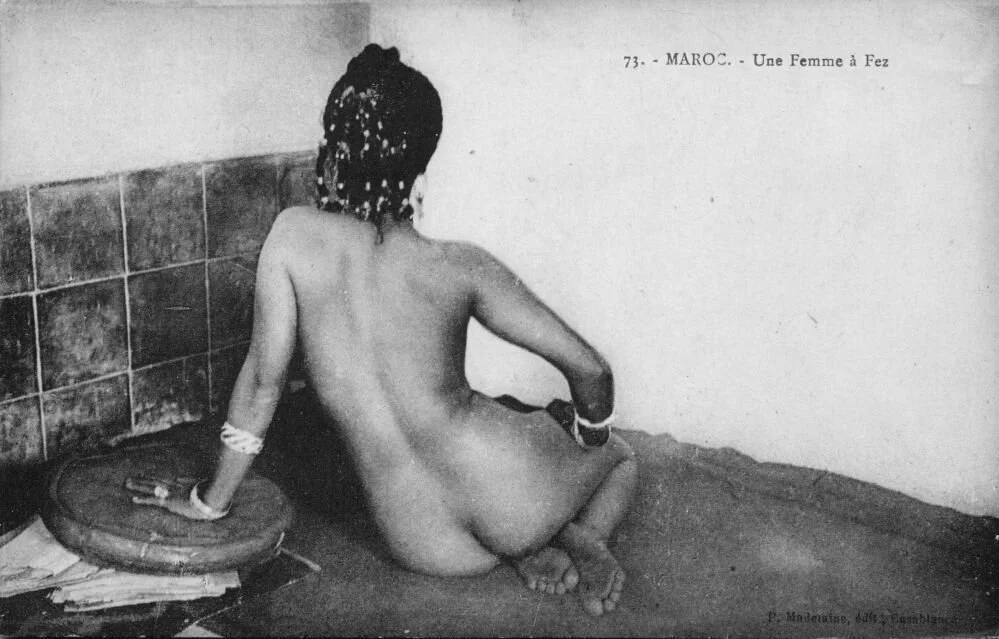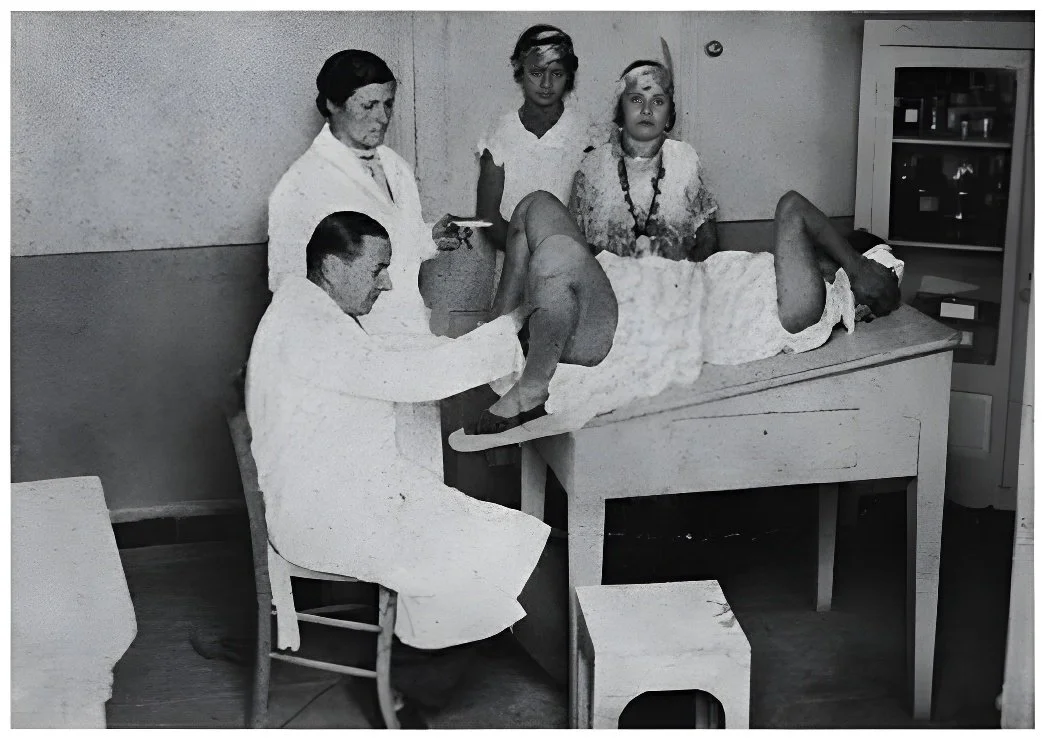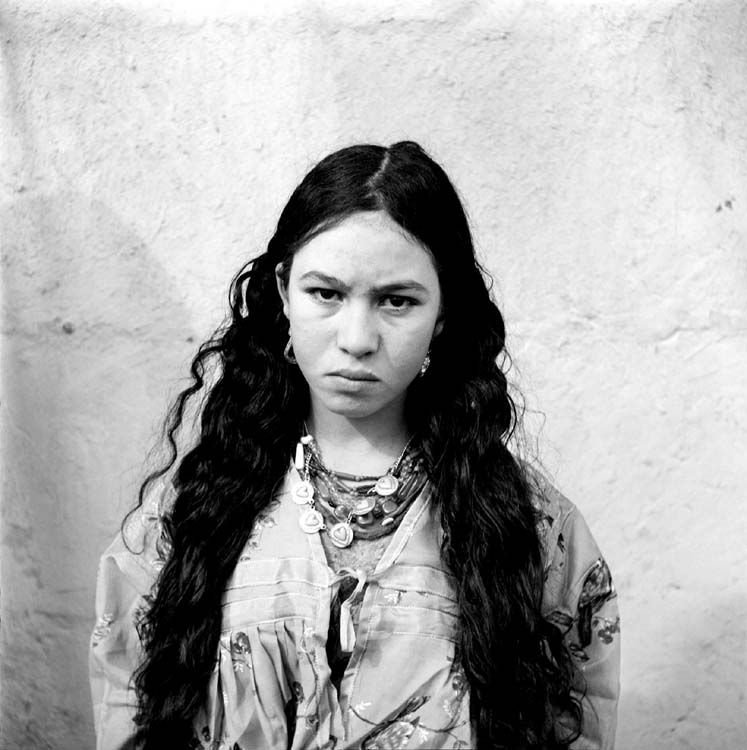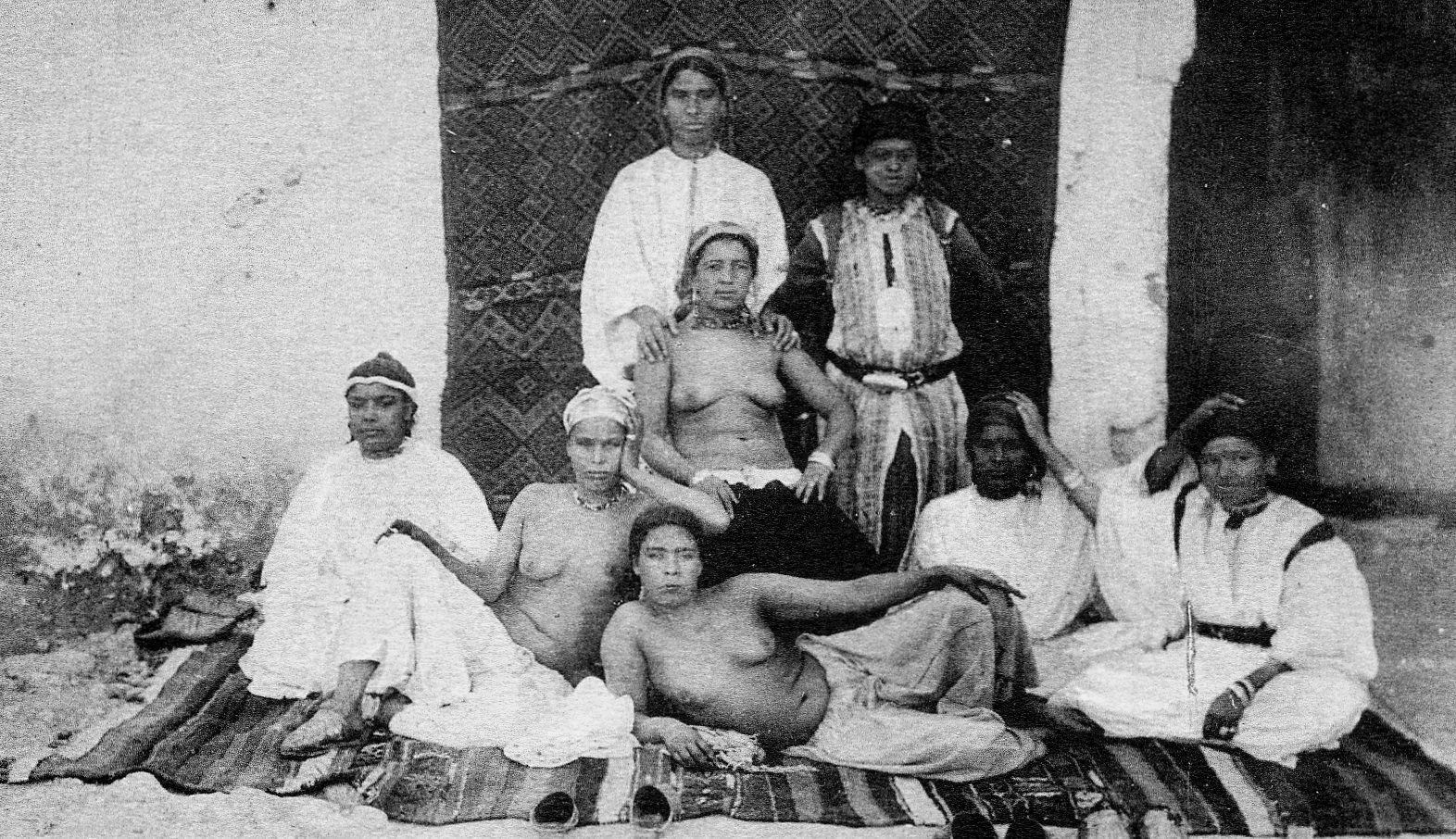From Gilead to Bousbir
Part of an ongoing development journal for The Ogress of Fez, a feature drama about Oum El Hassen and the intersecting forces of empire, gender, and violence. Learn more.
I have been rewatching The Handmaid's Tale television series, and what strikes me most is how close it feels - emotionally, certainly, but also in the histories it brings to the surface.
It feels like something we have already witnessed… systems that weaponise the female body through surveillance, regulation, and force.
They are patterns.
And it’s not merely a work of fiction set in some sterile, dystopian near-future. Gilead is not only an imagined place.
In many ways, it is a memory.
It recalls the real-world systems that have shaped and controlled women’s bodies, especially under empire.
Systems that were practiced, codified and aestheticised in places like colonial Morocco.
One of them was called Bousbir.
Still from The Handmaid’s Tale
Women in Bousbir, the colonial red-light district of Casablanca, photographed for a French postcard.
I came to Bousbir through my own screenplay-in-progress, The Ogress of Fez, a film that confronts the taboo history of colonial prostitution, a subject pushed to the margins of historical record, and rarely addressed on screen.
The more I read, the more I realise that what I first took for history is something far more present. What has been buried has not disappeared. The archive does not sit quietly… it pulses.
Like roots pushing through concrete, the past makes itself felt.
In many ways, Atwood’s fictional Gilead offers a strange kind of key; a model of how power organises itself around the female body, how language and routine work together to produce submission, how memory becomes both a threat and a form of resistance.
In Gilead, women of reproductive age are stripped of their names and identities. They are assigned to men, to homes, to roles. Their movements are monitored. Their speech is policed. Their bodies are subject to regular inspections to determine whether or not they are useful to the state. These rituals are draped in the language of scripture, but their function is clinical.
Reproductive capacity becomes the basis of worth.
The body is no longer one’s own.
It belongs to the system.
Still from The Handmaid’s Tale. A handmaid’s body monitored under state control.
Colonial brothel infirmary in Morocco, where women were forced to undergo weekly medical checks.
Bousbir was different in form, but not in logic. Built in 1923 by the French colonial administration in Casablanca, Bousbir was a walled-off red-light district, designed to house and regulate the sexual labour of Moroccan women. It was not some underground operation… it was sanctioned, designed, and legal.
The women who lived there were not free.
They were confined.
Renamed.
Medically inspected.
Photographed.
Taxed.
Many were recruited under the guise of work, others coerced. Most came from poverty. Once inside, their bodies were rendered public property, structured for consumption and state control.
The French described Bousbir as a hygienic solution, a moral containment strategy to protect soldiers and settlers from disease and chaos. But Christelle Taraud’s research makes clear what this “hygiene” actually meant.
The women underwent weekly genital inspections, often invasive, often public. The clinic rooms were lined with stirrups. Women sat on mats, barefoot, waiting for their turn to be inspected. The process was swift, clinical, and humiliating. They were sorted, treated if necessary, and returned to their rooms.
There was no consent.
The system didn’t require it.
Photographs taken during these inspections, many of which appear in the 1937 volume Hygiène, médecine et chirurgie au Maroc, show women mid-examination, partially clothed, surrounded by white-coated medical staff. Some turn away from the camera. Others hide their faces. The composition is orderly, even staged. The rooms are bright. The beds are aligned. The uniforms are spotless. But the images themselves are violent. They were records of power, and tools of spectacle. Susan Sontag wrote that “to photograph is to appropriate the thing photographed.” In Bousbir, photography did more than appropriate. It transformed the women into colonial commodities. Postcards, trophies, evidence of imperial progress.
This is what I find so chilling in both Gilead and Bousbir. Both the violence and the calmness around it.
The bureaucracy.
The logic.
The ritual.
In The Handmaid’s Tale, the Commanders justify their actions with religious language and talk of duty. In the colonial archive, the French administrators write of security, order, cleanliness. The tone is measured. The violence is procedural. It is embedded in scheduling systems, medical routines, architectural design. Atwood captures this perfectly. Her dystopia is so unsettling because it feels designed, tested, and entirely rational, at least to those who built it.
Foucault described this as biopower; the management of life by the state through the control of bodies, reproduction, and public health, rather than through an overt threat of violence. In both Bousbir and Gilead, women’s lives are regulated by ideology as well as institutional routines. Surveillance, more than observation, is a system of recording, categorising, and assigning value. Who is clean? Who is fertile? Who is obedient? The medical file becomes a form of scripture. The inspection replaces the confession. The clinic becomes a confessional booth with specula instead of sacraments.
I keep thinking about how the women in Bousbir were photographed. Not as individuals, but as objects of a colonial fantasy. The images were not meant to preserve memory, but to serve a system. Most were anonymous. No names, often no clear faces. What mattered was not who they were, but what they represented. The ideal “Mauresque”, beautiful, passive, veiled but available. Orientalism packaged as science. Sexual control masquerading as social reform.
French colonial postcard titled “Une femme à Fez.” One of many eroticised images produced and circulated to satisfy European fantasies of North African women.
In Gilead, there is a similar erasure of individuality. The handmaids wear identical red robes. They greet each other with the same ritual phrases: “Blessed be the fruit.” “May the Lord open.” Their identities are overwritten by the roles they are forced to play. They become vessels, symbols, signs. They are visible, but not seen. They are named, but not known.
What links these two systems is not only the management of women’s bodies, but also, and perhaps more disturbingly, the removal of their subjectivity. They are not allowed to narrate their own experience.
In The Handmaid’s Tale, the silence is broken by June’s voiceover - narration as testimony, spoken from inside the system that tries to erase her. In Bousbir, no such voices remain in the record. The archive is built from the outside: doctors, officials, photographers. It is a structure of absence. As Saidiya Hartman asks, how can we revisit these scenes of subjection without replicating the violence that silenced them in the first place?
What continues to haunt me, and shapes the emotional core of The Ogress of Fez, is the way violence was justified as public health… rational, necessary, and for the women’s own good..
In Bousbir, the weekly inspections were photographed as orderly and scientific. The rooms were bright and symmetrical. The nurses wore clean blouses. The women sat in rows. There was even a sense of choreography to it, an illusion of calm, clinical neutrality. But this performance concealed something far more brutal. The forced genital examinations, carried out with little or no privacy, were deeply violating. And yet in the visual record, they are rendered sterile, almost serene.
There is something similarly staged in The Handmaid’s Tale. The ceremonies of Gilead are highly choreographed - the ritualised rape, the birthing process, the salvagings. Each event is imbued with symbolism and performed in matching outfits, on manicured lawns or candlelit parlours. But this symbolism is hollow. It functions to legitimise. To cloak cruelty in reverence. To naturalise domination.
Everything is designed to look respectable.
Christelle Taraud argues that Bousbir was not only a site of sexual labour, but a theatre of colonial order. It was laid out like a medina, with narrow alleys, keyhole arches, and zellige tiling; an Orientalist fantasy built by French architects. The space itself became part of the performance. Tourists were invited in. Postcards were sold. Photographers like Marcelin Flandrin posed women in so-called “traditional” dress, arranged them in their rooms, lit them carefully. The images often appear in books and archives today without context, as if they were neutral glimpses of culture.
One of the most striking photographs from Bousbir, published in the 1937 colonial medical volume, shows a woman in stirrups mid-examination. The woman’s face is turned away. Her body is exposed, her agency erased. But what I keep noticing, and what Taraud points to, is the woman in the foreground, off-centre, who stares directly at the camera. Her face is closed. Her eyes are not pleading, but confrontational. There is no consent in that look. No complicity. It is not dramatic, but it is powerful. It says: I see you.
A woman undergoes routine examination under colonial regulation, Morocco, 1930s.
That is a gesture I want to hold onto. In systems built to erase subjectivity, even small refusals matter. Averted eyes. Folded arms. A name remembered. A story passed on in fragments. In Gilead, June carves words into the wood. She hides messages. She tells stories in her head to stay whole. In Bousbir, there are fewer traces. But they exist… in gaps, silences, contradictions. Some women escaped. Others negotiated with guards. Some managed to work only part-time, or to support each other quietly. These moments are rarely written down, but that does not mean they are lost.
Still from The Handmaid’s Tale
When I read Taraud, I’m struck by her insistence that Bousbir was not simply a place of domination, but of “violent negotiation.” That word is key.
Negotiation implies tension. Imbalance. Struggle. It acknowledges the possibility of friction, even in systems designed to suppress it. The women of Bousbir were not passive. They were constrained, but not absent. Their subjectivity was not recorded in the official sense, but it flickers in the background. In the posture of a shoulder. In the expression of a frown. In the choice to cover a face just before the shutter clicked.
This idea of the flicker - the trace of resistance inside the machinery of power - feels essential to the project I’m writing. The Ogress of Fez is not a historical film in the conventional sense. It’s fragmented and sensory.
What stays with me most from all this research, and from returning again and again to The Handmaid’s Tale, beyond violence that is both implicit and explicit in these systems, is the silence they produce. In what is left behind, the way the historical record so often fails to hold the texture of a person’s life, the tone of her voice, the detail of her resistance.
Bousbir, for all its documentation, is a place of erasure. There are maps, medical files, financial records, photographs. The archive is full. But it is full of other people speaking: doctors, photographers, colonial officials.
What we don’t have is what the women thought of their lives.
We don’t know how they endured, or how they told their stories to themselves.
We don’t know what was said between them, behind the clinic doors or after hours.
What they feared, what they hoped for.
We have only fragments, and those are mediated through the lens of power.
Saidiya Hartman calls this “the violence of the archive”, the way that silence itself becomes part of the domination. She asks how we might tell these stories without simply repeating the terms of their erasure. How we might approach historical subjects with care, without speaking for them or reducing them to symbols of suffering. She offers the idea of “critical fabulation”, a method of imagining into the gaps, writing with, not over, the silence.
That idea sits at the centre of The Ogress of Fez. I am not trying to reconstruct Bousbir as it was. I am trying to listen to its edges. To what resists translation. To the emotional weight of what’s missing. The film is made of glimpses, overheard conversations, interrupted rituals, women speaking off-screen.
Sometimes I wonder what it means for me to be telling this story at all. I am not a woman. I did not live through Bousbir.
But I am connected to Morocco, and to a lineage of women whose stories I only partly know, women who migrated, who disappeared, who were spoken about in half-sentences, whose names shifted in the telling.
There is a deep unease in me about what was passed down and what was not. This film, in many ways, is a way of sitting with that discomfort. Of not solving it, but staying inside it long enough to understand its shape.
In The Handmaid’s Tale, June is given a voice. She narrates her own story, even when there is no guarantee of an audience. That act of speaking, of remembering, becomes its own form of resistance. Her voice threatens Gilead through persistence, through witness, through her refusal to be erased.
Bousbir has no such narrator. Or rather, it has thousands of narrators, but their voices were not preserved. What we have are the walls. The routines. The photographs. And the silences between them.
What I’m learning, slowly, is that silence is not the same as absence. That what can’t be fully recovered can still be felt. That the act of imagining, carefully, with humility, can be a form of attention. I don’t want to fill in the gaps with certainty. I want to stay close to the uncertainty itself. To write what might have been sensed, not simply what happened.
A breath.
A refusal.
A word unsaid.
The Ogress of Fez is my way of returning to those rooms. To feel what it meant to live through it. To remember that even in the most controlled environments, even under inspection, even under His eye, there is still something that escapes.
Sometimes it’s just a gesture. A face turned away from the lens. A story told in secret. A robe left slightly unbuttoned. A woman who sees, but does not speak.
And sometimes, that is enough to begin again.
